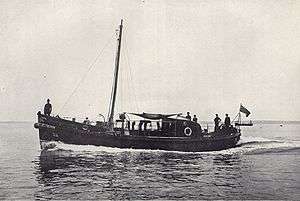RNLB William and Kate Johnstone (ON 682)
 RNLB William and Kate Johnstone | |
| History | |
|---|---|
| Owner: | Royal National Lifeboat Institution (RNLI) |
| Builder: | J Samuel White & Co, Cowes, Isle of Wight |
| Official Number: | ON 682 |
| Donor: | gifts from Mr. Stewart and his sister Mrs. W. Kendall |
| Station | New Brighton |
| Cost: | £16,084 |
| Launched: | Summer of 1923 |
| Christened: | By Mrs. Stewart Johnston, 24 September 1924 |
| Acquired: | 1923 |
| Decommissioned: | 1950 |
| Fate: | preserved in a seagoing condition in Ramsgate, Kent, and is available for charter, training and corporate hospitality. |
| General characteristics | |
| Class and type: | Barnett |
| Type: | Motor Lifeboat |
| Displacement: | 43 tons 2cwt |
| Length: | 59 ft 9 in (18.21 m) overall |
| Beam: | 14 ft 9 in (4.50 m) |
| Installed power: | Two D.E. Six-cylinder, 80 hp submersible petrol engins |
| Propulsion: | 2 X pitch propellers in tunnels |
| Speed: | 9.5 kn (17.6 km/h) |
| Range: | 300 nmi (560 km) |
RNLB William and Kate Johnston (ON 682) was a Barnett-class lifeboat[1] stationed at New Brighton in the English county of Merseyside from the summer of 1923[2] until 1950. The lifeboat was designed as a prototype by James R. Barnett[3] who was a consulting naval architect to the Royal National Lifeboat Institution. She was the first Barnett-class lifeboat and at the time of her launch, she was the largest lifeboat in the world.[3]
Design and construction
This new design of motor lifeboat was a radical[3] departure from previous RNLI rescue boats. It was nearly 60 feet (18 m) long with a beam of close to 15 feet (4.6 m). The William and Kate Johnston was pushed through the water with twin propellers[3] which were housed in tunnels. To drive these propellers there were two new D.E. six-cylinder submersible petrol engines of 80 horsepower.[3] Each engine was housed in its own chamber, with entirely separate fuel and cooling systems.[3] Each of these was watertight and was capable of running if the engine room became flooded and the engine was entirely submerged. The engines air intakes were set well above the waterline even when the boat was waterlogged. The Barnett-class could cruise at 9.5 knots (17.6 km/h)[3] and had an operating range of 300 nautical miles (560 km).[3] The class was also the first RNLI that rely solely on it engines for its motive power although the Barnett was equipped with a small staysail and trysail for stability purposes.
Hull construction
The hull was constructed of timber and was divided into fifteen[3] watertight compartments. The lifeboat was also the first motor lifeboat to be built with flush decks, similar to earlier steam driven lifeboats. There was a semi enclosed deck shelter which housed the on deck helm position which helped to keep the crew out of bad weather launches. Below deck there was also a cabin which could accommodate up to twenty four[3] people. If necessary the Barnett class lifeboat was capable of caring a total of 130 rescued people.[3]
References
- ↑ Ships For All: By Bowen, Frank C: Published by Ward, Lock & Co., Ltd, London and Melbourne: Second Edition
- ↑ Heroes All!, The story of the RNLI, By Beilby, Alec: Published By Patrick Stephens Ltd (1992): ISBN 1-85260-419-0
- 1 2 3 4 5 6 7 8 9 10 11 Rescue at Sea: By Evans, Clayton: Published by Conway (2003): ISBN 0-85177-934-4